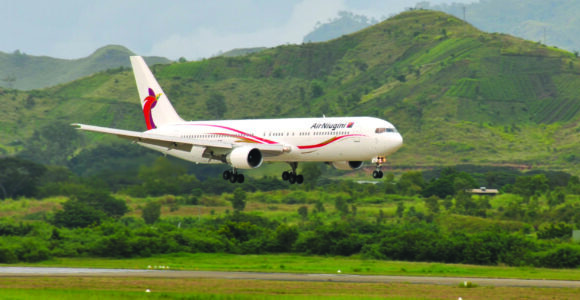Air Niugini CEOs past and present reflect on the trials and tribulations of Papua New Guinea’s national airline, during the COVID-19 pandemic and how it has prevailed since. Peter Wilmoth reports.

Air Niugini weathered the COVID-19 storm but the Airline’s Acting CEO Gary Seddon says it was a “distressing time”.
When news began spreading in the first weeks of 2020 of a respiratory virus racing across the world, no-one could know the impact it would have.
Soon to be named COVID 19, the once-in-a-hundred-year event shook the world, hitting airlines and associated businesses around the world first, and hard.
Across the world, air travel virtually ceased. Alan Milne was serving the last few weeks of his role as Air Niugini’s Chief Executive Officer.
“It became very challenging to try and maintain some form of service. Even though we were flying, the company had to scale right back.”
“The last few weeks I was there were pretty tense, and not just for the airline,” he remembers. “It was the PNG people, the Government trying to get their heads around what it would look like if this started running wild, especially in the Highlands community where it was going to be very difficult to contain.

Former CEO Alan Milne
“I was at Qantas for 36 years and for a time I ran the integrated operations centre, so I had crisis management responsibility as well. None of us knew the gravity of it when we first heard about it. At Qantas, I’d been through the SARS crisis and thought maybe it was going to be similar but of course it was worse than that, as we now know.”
Milne activated the airline’s emergency responses, including a designated ‘crisis room’. Given the importance of the airline to the country, Air Niugini worked closely with the PNG government’s crisis response team.
Changes were made immediately. Air Niugini stopped serving catering on board, removed the inflight magazines so multiple people weren’t handling them and tried distancing passengers, but, as Milne says, “numbers of passengers reduced anyway so we could spread them out throughout the cabin”.
Devastating time

Air Niugini’s Acting CEO Gary Seddon.
In March 2020, Milne stepped down and Bruce Alabaster took up the CEO role. In March 2023 Gary Seddon was appointed Acting Chief Executive Officer.
Seddon describes it as “a tremendously distressing time”.
“COVID devastated the airline industry not only in the region but around the world – 160 million jobs lost and billions of dollars,” he says.
“For Air Niugini, it was an interesting time because in March 2020, as the world closed down, as the borders in Australia shut, Air Niugini’s future suddenly became very, very shaky. However, in a very short period of time, once Qantas had stopped altogether and all of the other airlines – Philippine Airlines stopped coming to PNG – it was very apparent that Air Niugini represented the single only means of transport between Australia, Singapore and Papua New Guinea.”
Lifeline service
In March 2020, the PNG government introduced the Pandemic Act and the Essential Services Act, which declared that air travel was fundamental.
With limited passenger travel Air Niugini was able to operate – mainly carrying freight – on just two routes: between Brisbane and Port Moresby, and Singapore and Port Moresby.
The services Air Niugini offered between those countries were heavily supported by both the PNG government and the Australian government to provide that single lifeline.
“On the domestic side, we provided a limited service – whenever there was a recorded case of COVID-19, whether it was in Eastern Highlands Province or West New Britain and so on, the province would shut down, all the flights would stop,” Seddon says.
“The baggage handlers in 2020, the check-in staff, the airport services, the caterers – they’d gone, went to jobs where they could pay their mortgages”
“It became very challenging to try and maintain some form of service. Even though we were flying, the company had to scale right back to its nucleus, to really the bare boards in terms of staffing, in terms of operations, everything.”
It was challenging maintaining staff levels.
“Well over a thousand employees were furloughed (and) early retirement programs (were brought in). Air Niugini tried to be as compassionate as possible, as I think most airlines did, but at some point you reach a critical point. I think the airline did as best as it could under the circumstances.”
Returning to “new normal”
When the borders to Australia opened on January 22, 2022, travel started getting back to a new normal.
It was clear that the industry had been devastated and “getting it back to pre-COVID conditions was going to be impossible in a short timeframe,” Seddon says.
There were “huge” supply chain issues and staffing issues.
“The baggage handlers in 2020, the check-in staff, the airport services, the caterers – they’d gone, went to jobs where they could pay their mortgages and so on.
“Cabin crew, pilots, the works; pilots were driving buses and trucks. And to recall all of that was going to take years, not days.”
The airline returned to what was called a “new normal” in terms of load factor and people travelling, but challenges did not stop when flying resumed.
“Places where we went to get our spares, those companies didn’t exist, they had to come out from other places. There was massive investment from the major airlines. For example, Boeing invested US$40 billion in the supply chain network just to provide appropriate spare parts and services for its new aircraft assembly. So, for us operating older aircraft, reconstituting the integrity of those supply chains was immensely challenging.”
The airline is now in happier times. Air Niugini is celebrating its 50th year with the effects of the pandemic that shook the world largely behind it.
Peter Wilmoth is a journalist and author currently working on a 50th anniversary book for Air Niugini. The book recounts the history of the airline over a half century and is a project of Business Advantage International, the publisher of this magazine. The book is due for release later this year.








Speak Your Mind